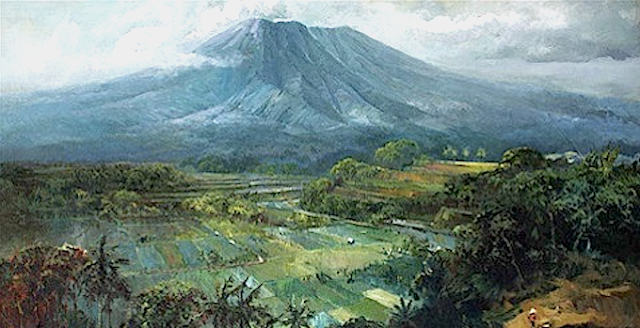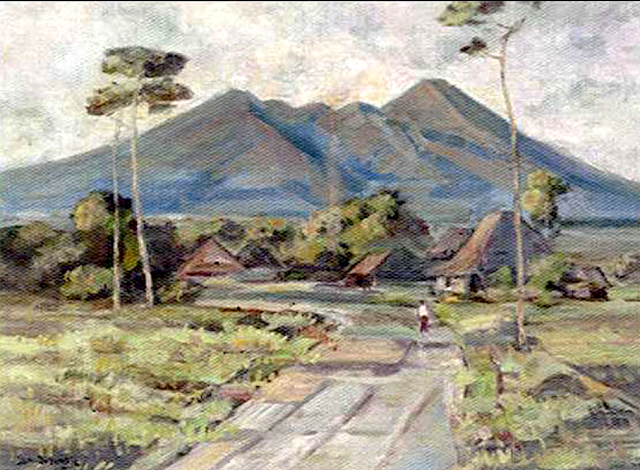Gunung Merapi (2,914m - 9,500 ft)
Indonesia (Java)
In Rice Fields near Gunung Merapi, Huile sur toile, 110 x 70 cm, Collection privée ( via Drouot)
Le mont Merapi ou Gunung Merapi (2
914 m - 9 500 pieds) est un stratovolcan très actif situé à la
frontière entre le centre de Java et Yogyakarta, en Indonésie. C'est le
volcan le plus actif d'Indonésie et il est régulièrement entré en
éruption depuis 1548. Il est situé à environ 28 kilomètres (17 mi) au
nord de la ville de Yogyakarta qui compte 2,4 millions d'habitants et
des milliers de personnes vivent sur les flancs du volcan à quelques que
1 700 mètres (5 600 pieds) au-dessus du niveau de la mer. On peut
souvent voir de la fumée émerger du sommet de la montagne et plusieurs
éruptions ont fait de nombreux morts. Le flux pyroclastique d'une
grande explosion a tué 27 personnes le 22 novembre 1994, principalement
dans la ville de Muntilan, à l'ouest du volcan. Une autre grande
éruption s'est produite en 2006, peu de temps avant le tremblement de
terre de Yogyakarta. À la lumière des dangers que Merapi pose aux zones
peuplées, il a été désigné comme l'un des "volcans les plus dangereux de la décennie". Le
25 octobre 2010, le gouvernement indonésien a relevé l'alerte pour le
mont Merapi à son plus haut niveau et a fait evacuer les villageois des
zones menacées. Les responsables ont déclaré qu'environ 500 tremblements
de terre volcaniques avaient été enregistrés sur la montagne au cours
du week-end du 23 au 24 octobre 2010 et que le magma était monté à
environ 1 kilomètre sous la surface en raison de l'activité sismique.
Dans l'après-midi du 25 octobre 2010, le mont Merapi a éclaté et la
lave a commencé à couler sans discontinuer sur ses pentes sud et
sud-est. La montagne était encore en éruption le 30 novembre 2010,
mais en raison de la baisse de l'activité éruptive le 3 décembre 2010,
le statut d'alerte officiel a été réduit au niveau 3. Le volcan mesure
maintenant 2930 mètres de haut, 38 mètres plus bas qu'avant les
éruptions de 2010. Après une grande éruption en 2010, la
caractéristique du mont Merapi a été modifiée. Le 18 novembre 2013, le
mont Merapi a éclaté de fumée jusqu'à 2 000 mètres de haut, l'une de ses
premières éruptions phréatiques majeures après l'éruption de 2010. Les
chercheurs ont déclaré que cette éruption s'est produite en raison de
l'effet combiné des gaz volcaniques chauds et des précipitations
abondantes. En 2004, une zone de 6 410 hectares autour du mont Merapi
a été érigée en parc national. La décision du ministère des Forêts de
déclarer le parc a ensuite été contestée devant les tribunaux par le
Forum indonésien pour l'environnement, au motif d'un manque de
consultation avec les résidents locaux. Lors de l'éruption du volcan en
2006, il a été signalé que de nombreux habitants hésitaient à partir
parce qu'ils craignaient que leurs résidences ne soient confisquées pour
l'expansion du parc national, ce qui signifie qu'ils n'auraient pas de
maison. La dernière éruption du Merapi est en date du 18 Mars 2023 et a nécessité l'évacuation de plusieurs centaines d'habitants.
Le peintre
Raden Soedjono Abdullah est né à Yogyakarta, le fils d'Abdullah Suriosubroto, un célèbre peintre paysagiste et était également le frère de Basoeki Abdullah.
Il avait l'habitude d'aider son père à nettoyer sa palette et c'est
ainsi qu'il a trouvé sa voie pour devenir peintre. Il a terminé ses
études à HIS Indonesian Dutch School et a travaillé comme affichiste
pour le Rex Theatre de Yogyakarta. Lors de la colonisation
japonaise en Indonésie, Sudjono s'exhila à Parangtritis, Parangkusumo où
il continua à peindre. Au cours des années 1970, Soedjono déménagea à
Kertosono dans l'est de Java, où il a vécu jusqu'à sa mort. Sa peinture
est beaucoup plus realiste - voit hyper réaliste même - que celle des
autres peintres de sa famille.
______________________________
2023 - Wandering Vertexes ....
Errant au-dessus des Sommets Silencieux...
Un blog de Francis Rousseau

%20%20DIeng%20Platea-%20Dieng%20Complex-%20%20In%20%20_voorstellend_de_tempel_Candi_Bima_op_het_Diengplateau_T1912-%20Tropenmuseum%20.jpg)
-%20Indonesian%20mountians.JPG)
















